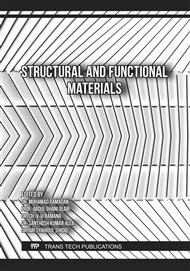[1]
M. Tawalbeh, A. Al-Othman, A. Ka'ki, A. Farooq, and M. Alkasrawi, "Lignin/zirconium phosphate/ionic liquids-based proton conducting membranes for high-temperature PEM fuel cells applications," Energy, vol. 260, p.125237, Dec. 2022.
DOI: 10.1016/j.energy.2022.125237
Google Scholar
[2]
H. L. Yeager and A. Steck, "Cation and Water Diffusion in Nafion Ion Exchange Membranes: Influence of Polymer Structure," J. Electrochem. Soc., vol. 128, no. 9, p.1880–1884, 1981.
DOI: 10.1149/1.2127757
Google Scholar
[3]
R. M. Nauman Javed, A. Al-Othman, M. Tawalbeh, and A. G. Olabi, "Recent developments in graphene and graphene oxide materials for polymer electrolyte membrane fuel cells applications," Renew. Sustain. Energy Rev., vol. 168, p.112836, Oct. 2022.
DOI: 10.1016/j.rser.2022.112836
Google Scholar
[4]
A. Ka'ki, A. Alraeesi, A. Al-Othman, and M. Tawalbeh, "Proton conduction of novel calcium phosphate nanocomposite membranes for high temperature PEM fuel cells applications," Int. J. Hydrogen Energy, vol. 46, no. 59, p.30641–30657, 2021.
DOI: 10.1016/j.ijhydene.2021.01.013
Google Scholar
[5]
R. M. Nauman Javed, A. Al-Othman, P. Nancarrow, and M. Tawalbeh, "Zirconium silicate-ionic liquid membranes for high-temperature hydrogen PEM fuel cells," Int. J. Hydrogen Energy, 2022.
DOI: 10.1016/j.ijhydene.2022.05.009
Google Scholar
[6]
A. Al-Othman et al., "Novel composite membrane based on zirconium phosphate-ionic liquids for high temperature PEM fuel cells," Int. J. Hydrogen Energy, vol. 46, no. 8, p.6100–6109, Jan. 2021.
DOI: 10.1016/j.ijhydene.2020.02.112
Google Scholar
[7]
Y. Wu et al., "Achieving high power density and excellent durability for high temperature proton exchange membrane fuel cells based on crosslinked branched polybenzimidazole and metal-organic frameworks," J. Memb. Sci., vol. 630, no. March, p.119288, 2021.
DOI: 10.1016/j.memsci.2021.119288
Google Scholar
[8]
A. Al-Othman, M. Tawalbeh, O. Temsah, and M. Al-Murisi, "Industrial Challenges of MOFs in Energy Applications," in Encyclopedia of Smart Materials, Elsevier, 2022, p.535–543.
DOI: 10.1016/b978-0-12-815732-9.00030-9
Google Scholar
[9]
D. R. MacFarlane et al., "Ionic liquids and their solid-state analogues as materials for energy generation and storage," Nat. Rev. Mater., vol. 1, no. 2, p.1–15, 2016.
DOI: 10.1038/natrevmats.2015.5
Google Scholar
[10]
A. Alashkar, A. Al-Othman, M. Tawalbeh, and M. Qasim, "A Critical Review on the Use of Ionic Liquids in Proton Exchange Membrane Fuel Cells," Membranes (Basel)., vol. 12, no. 2, p.178, Feb. 2022.
DOI: 10.3390/membranes12020178
Google Scholar
[11]
M. Tawalbeh, A. Al-Othman, A. Ka'ki, A. Farooq, and M. Alkasrawi, "Highly proton conductive membranes based on lignin/ZrP/PTFE composite for high temperature PEM fuel cells," in 2022 Advances in Science and Engineering Technology International Conferences (ASET), 2022, p.1–5.
DOI: 10.1109/ASET53988.2022.9734834
Google Scholar
[12]
A. Al-Othman, M. F. Hassan, M. Tawalbeh, and A. Ka'ki, "Proton Conductivity Studies in Zirconium Phosphate/MXenes in PEM Fuel Cells," in 2022 Advances in Science and Engineering Technology International Conferences (ASET), Feb. 2022, p.1–5.
DOI: 10.1109/ASET53988.2022.9735033
Google Scholar
[13]
H. Mohammed, A. Al-Othman, P. Nancarrow, Y. Elsayed, and M. Tawalbeh, "Enhanced proton conduction in zirconium phosphate/ionic liquids materials for high-temperature fuel cells," Int. J. Hydrogen Energy, vol. 46, no. 6, p.4857–4869, Jan. 2021.
DOI: 10.1016/j.ijhydene.2019.09.118
Google Scholar
[14]
M. J. Katz et al., "A facile synthesis of UiO-66, UiO-67 and their derivatives," Chem. Commun., vol. 49, no. 82, p.9449, 2013.
DOI: 10.1039/c3cc46105j
Google Scholar
[15]
H.-L. Lin, S.-H. Yeh, T. L. Yu, and L.-C. Chen, "Silicate and zirconium phosphate modified Nafion/PTFE composite membranes for high temperature PEMFC," J. Polym. Res., vol. 16, no. 5, p.519–527, Sep. 2009.
DOI: 10.1007/s10965-008-9255-6
Google Scholar
[16]
A. Al-Othman, A. Y. Tremblay, W. Pell, Y. Liu, B. A. Peppley, and M. Ternan, "The effect of glycerol on the conductivity of Nafion-free ZrP/PTFE composite membrane electrolytes for direct hydrocarbon fuel cells," J. Power Sources, vol. 199, p.14–21, 2012.
DOI: 10.1016/j.jpowsour.2011.09.104
Google Scholar
[17]
U. R. Farooqui, A. L. Ahmad, and N. A. Hamid, "Graphene oxide: A promising membrane material for fuel cells," Renew. Sustain. Energy Rev., vol. 82, p.714–733, 2018.
DOI: 10.1016/j.rser.2017.09.081
Google Scholar
[18]
S. Wang et al., "UiO-66-NH2 functionalized cellulose nanofibers embedded in sulfonated polysulfone as proton exchange membrane," Int. J. Hydrogen Energy, vol. 46, no. 36, p.19106–19115, 2021.
DOI: 10.1016/j.ijhydene.2021.03.033
Google Scholar
[19]
G. Mensitieri et al., "Preparation of Covalent-Ionically Cross-Linked UiO-66-NH 2 /Sulfonated Aromatic Composite Proton Exchange Membranes With Excellent Performance," Front. Chem. | www.frontiersin.org, vol. 8, p.56, 2020.
DOI: 10.3389/fchem.2020.00056
Google Scholar
[20]
N. Shahkaramipour, T. N. Tran, S. Ramanan, and H. Lin, "Membranes with surface-enhanced antifouling properties for water purification," Membranes (Basel)., vol. 7, no. 1, p.13, 2017.
DOI: 10.3390/membranes7010013
Google Scholar



